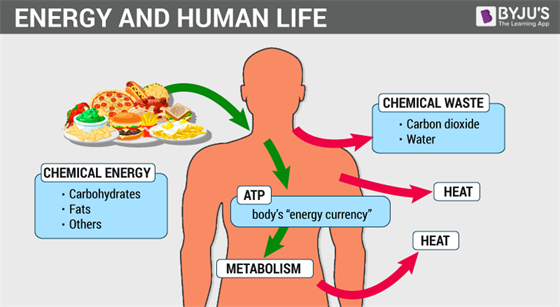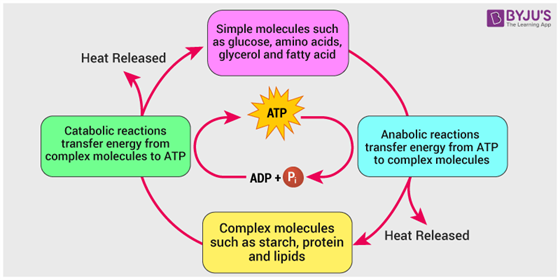Which of the Following Metabolic Processes Uses the Most Energy
The Generation of ATP from Glucose. It was probably one of the earliest metabolic pathways to evolve since it is used by nearly all of the organisms on earth.
A General Overview Of The Major Metabolic Pathways
Glucose is phosphorylated before it is split into two three-carbon molecules.

. Overview of metabolic pathways energy flow in a cell and anabolism and catabolism. The breakdown of TAGs provide twice as much energy per gram compared with the utilisation of carbohydrates and proteins. Living things consume sugar as a major energy source because sugar molecules have a great deal of energy stored within their bonds.
The laws of thermodynamics. During short-term intense activities a large amount of power needs to be produced by the muscles creating a high demand for ATP. Second Law of Thermodynamics and entropy.
The breakdown of glucose a simple sugar is described by the equation. Although its last to kick in the oxidative system is the most important energy system of all. This is a classic example of one of the many cellular processes that use and produce energy.
Biology questions and answers. During the energy payoff phase of glycolysis __________. Depending on the hydrogen source used to reduce CO2 both photolithotrophic and photoorganotrophic reactions exist in bacteria.
The energy-yielding reactions within the cell are therefore coupled to ATP synthesis while the energy-requiring reactions are coupled to ATP hydrolysis. Citric Acid Cycle - 2 ATP B. C liver glycogen is important in maintaining blood glucose concentration.
Hoc respiration aerobic respiration fermentation glycolysis. B elite endurance runners have a high proportion of type I fibers in their leg muscles. The heart the most energy-expensive organ in the body utilises fatty acids for 5070 of its energy.
A Reactions that convert light energy to chemical energy B Reactions that split H2O molecules and release 02 C Reactions that store energy by pumping H across membranes D Reactions. A muscle glycogen is broken down by enzymatically to glucose-1-phosphate. Glucose Oxygen Carbon dioxide Water Energy as 30-32 ATP The body releases carbon dioxide and water in this process.
So if you have SLOW and STEADY energy requirements your NET ENERGY PRODUCTION from aerobic respiration equals 30-32 Molecules of ATP. During the energy investment phase of glycolysis __________. 3 NADH H are produced per each acetyl CoA that enters the citric acid cycle.
D Question 10 Consider the following metabolic processes. For example one metabolic pathway for carbohydrates breaks large molecules down into glucose. Oxidative athletes are typically leaner and lighter than the other two athletic types.
Autotrophy is a unique form of metabolism found only in bacteria. NADH and ATP are produced. For each glucose that enters glycolysis _____ NADH H are produced by the citric acid cycle.
Consider the metabolism of sugar. Reaction coupling to create glucose-6-phosphate. Aerobic respiration anaerobic respiration glycolysis fermentation First option is incorrect because chaices are no View the full answer.
The metabolism of sugar a simple carbohydrate is a classic example of the many cellular processes that use and produce energy. Which choice shows these arranged in order from the process that produces the most energy to the process that produces the least or nol energy. In chemiosmosis what is the most direct source of energy that is used to convert ADP Pi to ATP.
Glycolysis - 2 ATP E. Most of the ATP in cellular respiration is produced by the process of chemiosmosis. This will theoretically burn the highest number of calories.
The second process produces energy and is referred to as catabolic. In cellular respiration most ATP molecules are produced by _____. Account for the no.
Energy metabolism is the general process by which living cells acquire and use the energy needed to stay alive to grow and to reproduce. First Law of Thermodynamics introduction. C 6 H 12 O 6 6O 2 6CO 2 6H 2 O.
Metabolic processes either use energy to build large molecules from smaller precursors anabolism or they release energy by breaking down large molecules into smaller products catabolism. Google Classroom Facebook Twitter. It takes place in the cytoplasm of both prokaryotic and eukaryotic cells.
They can go on forever at a slow-to-medium pace burning mostly fat the ultimate high-efficiency slow-burning fuel. Belarmino Lara Ysabel R. Glycolysis is the first pathway used in the breakdown of glucose to extract energy.
Which of the following processes generates the most ATP. If it doesnt work neither do you. 6 of the following metabolic processes which one is common to or a characteristic of photosynthesis AND cellular respiration.
Carbon dioxide is reduced to glucose which is used for both biosynthesis and energy production. The process does not use oxygen and is therefore anaerobic. The first of these processes requires energy and is referred to as anabolic.
The phosphagen system also called the ATP-CP system is the quickest way to. BSN 1Y2-7 HW8- Metabolism 1 1. The high-energy bonds of ATP thus play a central role in cell metabolism by serving as a usable storage form of free energy.
Biology questions and answers. Catabolic processes involve breaking down large biomolecules and capturing the energy contained within those molecules for other purposes. Each glucose produces two pyruvates each of which is converted into acetyl CoA.
All of the listed responses are correct. Another metabolic pathway might build glucose into large carbohydrate molecules for storage. Fatty Acid oxidation - 129 ATP C.
Living things consume sugars as a major energy source because sugar molecules have a great deal of energy stored within their bonds. Pentose phosphate pathway - 1 ATP. A energy released as electrons flow through the electron transport chain B energy released from substrate-level phosphorylation C energy released from movement of protons through ATP synthase down their electrochemical gradient D energy released as electrons.
The correct order of the process that produces the most energy to the process that produces the least or no energy is. Glycogenolysis - 31-33 ATP D.

Energy And Metabolism Boundless Biology


No comments for "Which of the Following Metabolic Processes Uses the Most Energy"
Post a Comment